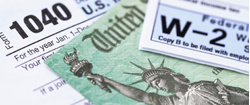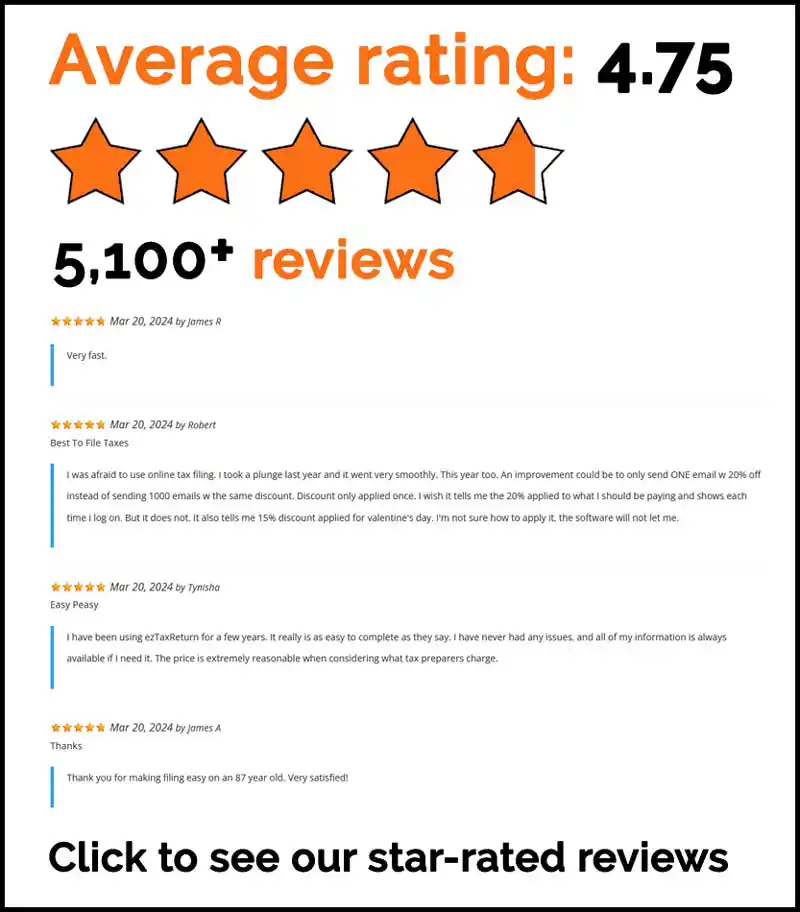The information in this article is up to date for tax year 2024 (returns filed in 2025).
You can’t control when you’ll get your tax refund but there is something you can do to speed up the process. Eight out of 10 taxpayers get their tax refund faster by using e-file and direct deposit refunds, which can arrive faster than paper checks. Using a checking account for receiving tax refunds through direct deposit offers advantages such as speed and security. Choosing direct deposit for your tax refund also comes with other benefits you can’t afford to miss.
It’s Easy to Set Up
Setting up direct deposit for your tax refund is extremely easy. All you need is your bank account and routing numbers which can be found on the bottom of your checks. The first set of numbers is the routing number, the second is the account number. When you finish preparing your federal and state returns with ezTaxReturn, you’ll be asked how you’d like to receive your refund. Choose direct deposit then enter your banking information. Direct deposits are faster, more secure, and convenient compared to paper checks. Always double and triple check your numbers because missing a digit will delay your refund. Verify the policies of your financial institutions regarding direct deposits to ensure a smooth transaction.
Direct Deposit Is Secure and Convenient
With direct deposit, your refund is electronically deposited, eliminating the chance of it being stolen or lost in the mail. Plus, you save yourself a trip to the bank because the money goes directly into your account. Once your return has been accepted, you can start tracking your refund using the IRS “Where’s My Refund?” tool. It’s the best way to find out when your money will be available.
Split Your Tax Refund Across Multiple Accounts
Did you know you can have your tax refund split into multiple accounts? When you e-file with tax software, you have the option to divide your refund between up to three different bank accounts. This is a great way to allocate funds for different purposes, like saving, paying off debt, or covering bills. Direct deposit makes it easy and efficient, and splitting your refund allows you to manage your finances the way that works best for you. Take advantage of this convenient feature when you file your taxes with ezTaxReturn!
Direct Deposit Tax Refund FAQs
- What is the benefit of using direct deposit for my tax refund? Using direct deposit for your tax refund is a safe, reliable, and convenient way to receive your federal tax refund. It eliminates the risk of lost, stolen, or misplaced checks and ensures that your refund is deposited directly into your bank account. This method also speeds up the process, so you get your money faster.
- Can I use direct deposit if I don’t have a bank account? No, you need to have a bank account to use direct deposit. However, you can consider opening a low-fee bank account or using a prepaid debit card as an alternative. Many prepaid debit cards come with account and routing numbers that you can provide to the IRS.
- How do I set up direct deposit for my tax refund? To set up direct deposit, you can select the direct deposit option when prompted by your tax software or provide your banking information to the IRS at the time you are submitting your taxes. Make sure to have your bank account number and routing number handy.
- Can I split my tax refund into multiple accounts? Yes, you can divide your refund into two or three additional financial accounts, including your Individual Retirement Account (IRA). You can use your tax software to do it electronically or use IRS’ Form 8888, Allocation of Refund, if you file a paper return.
- What happens if my financial institution rejects my direct deposit refund? If your financial institution rejects your direct deposit refund, you will receive a paper check. You should contact your financial institution to ensure they will accept your direct deposit and verify your account and routing number to avoid any issues.
- Can I use a prepaid debit card to receive my tax refund? Yes, many reloadable prepaid cards have account and routing numbers that you can provide to the IRS. However, you should check with the financial institution to ensure your card can be used and to obtain the routing number and account number.
- How long does it take to receive my tax refund with direct deposit? With direct deposit, you can receive your tax refund in less than 21 days after filing your federal tax return. This is significantly faster than waiting for a paper check to arrive in the mail.
- Is direct deposit secure? Yes, direct deposit is a secure way to receive your tax refund. It eliminates the risk of lost, stolen, or misplaced checks and ensures that your refund is deposited directly into your bank account.
- Can I track the status of my tax refund? Yes, you can track the status of your federal tax return using IRS’ Where’s My Refund? tool. This tool provides updates on the status of your refund and when you can expect it to be deposited into your account.
- What are the benefits of using direct deposit for my tax refund? The benefits of using direct deposit for your tax refund include convenience, reliability, security, and no need to wait for your check to arrive in the mail. It’s the fastest way to get your refund deposited directly into your bank account.
Ready to get your refund fast? File your taxes with ezTaxReturn today and choose direct deposit for the quickest, most secure refund. Plus, we guarantee you’ll get the biggest refund possible!
The articles and content published on this blog are provided for informational purposes only. The information presented is not intended to be, and should not be taken as, legal, financial, or professional advice. Readers are advised to seek appropriate professional guidance and conduct their own due diligence before making any decisions based on the information provided.




